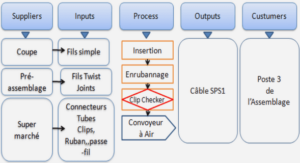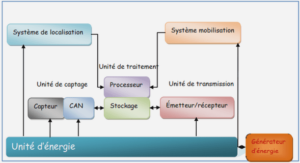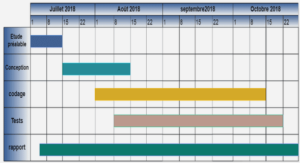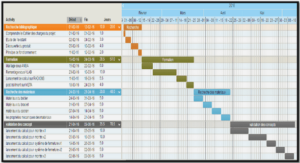Changements dans l’écosystème arctique
Demographic response of tundra small mammals to a snow fencing experiment
Bilodeau, F., Reid, D.G., Gauthier, G., Krebs, C.J., Berteaux, D. & Kenney, A.J. 2013. Demographic response of tundra small mammals to a snow fencing experiment. Oikos (in press). doi: 10.1111/j.1600-0706.2012.00220.x.
Résumé
Le couvert de neige constitue un élément environnemental clé pour la faune de la toundra qui va être affecté par les changements climatiques. L’altération du couvert de neige pourrait affecter la dynamique des populations de petits mammifères aux hautes latitudes, qui sont actifs tout l’hiver et se reproduisent sous la neige. Nous avons testé expérimentalement l’hypothèse qu’un couvert de neige plus épais augmenterait les densités et les taux de reproduction hivernale, mais que la prédation par les mustélidés pourrait être plus élevée aux endroits où les densités de petits mammifères sont plus élevées. Nous avons augmenté l’épaisseur du couvert de neige en installant des clôtures à neige sur trois sites dans l’Arctique Canadien (Île Bylot, Nunavut, l’Île Herschel et Komakuk Beach, Yukon) sur des périodes variant de 1 à 4 années. Les densités de nids d’hiver étaient plus élevées là où le couvert de neige avait été augmenté, mais les densités au printemps n’ont pas augmenté dans les zones expérimentales.
Les lemmings se déplacent probablement des zones de fort enneigement, leurs habitats hivernaux préférés, vers leurs habitats estivaux pendant la période de fonte de la neige, lorsque les avantages associés à un couvert de neige plus épais sont disparus. Notre traitement n’a pas eu d’effet sur les signes de reproduction dans les nids d’hiver, sur la proportion de femelles reproductrices ni sur la proportion de juvéniles capturés au printemps, ce qui suggère que le couvert de neige plus épais n’a pas augmenté la reproduction. Nos résultats sur la prédation étaient incohérents à travers les sites puisque la prédation par les mustélidés était plus élevée dans la zone expérimentale pour un site, mais plus basse aux deux autres sites et n’était pas plus élevée dans les agrégations de nids. Bien que cette expérience nous a procuré plusieurs pistes sur l’impact qu’a le couvert de neige sur la dynamique des populations des petits mammifères de la toundra, elle nous a aussi exposé les défis et les difficultés associés avec des expériences à grande échelle ayant pour but de manipuler un facteur climatique critique.
Abstract
Snow cover is a key environmental component for tundra wildlife that will be affected by climate change. Change to the snow cover may affect the population dynamics of high-latitude small mammals, which are active throughout the winter and reproduce under the snow. We experimentally tested the hypotheses that a deeper snow cover would enhance the densities and winter reproductive rates of small mammals, but that predation by mustelids could be higher in areas of increased small mammal density. We enhanced snow cover by setting out snow fences at three sites in the Canadian Arctic (Bylot Island, Nunavut, and Herschel Island and Komakuk Beach, Yukon) over periods ranging from 1 to 4 years. Densities of winter nests were higher where snow depth was increased but spring lemming densities did not increase on the experimental areas. Lemmings probably moved from areas of deep snow, their preferred winter habitat, to summer habitat during snow melt once the advantages associated with deep snow were gone. Our treatment had no effect on signs of reproduction in winter nests, proportion of lactating females in spring, or the proportion of juveniles caught in spring, which suggests that deep snow did not enhance reproduction. Results on predation were inconsistent across sites as predation by weasels was higher on the experimental area at one site but lower at two others and was not higher in areas of winter nest aggregations. Although this experiment provided us with several new insights about the impact of snow cover on the population dynamics of tundra small mammals, it also illustrates the challenges and difficulties associated with large-scale experiments aimed at manipulating a critical climatic factor.
Introduction
Climatic conditions in the Arctic are changing rapidly with increasing temperature and shifting precipitation regimes (Solomon 2007, Hannah 2011). These changes will inevitably affect the snow cover, a key environmental component of the tundra for many animals (Chan et al. 2005, Forchhammer et al. 2005, Tyler et al. 2008, Gilg et al. 2009,). During the winter, snow provides a vital protective cover for tundra plants and for some wildlife species, most notably small mammals that live under the snow (Callaghan et al. 2004). Arctic small mammal populations are famous for their multi-annual population cycles (Stenseth 1999, Krebs et al. 2002, Ims and Fuglei 2005, Pitelka and Batzli 2007, Gruyer et al. 2008), the causes of which are still far from fully understood (Krebs 2011). Recently, lemming and vole cycles have become less regular, and with a reduced amplitude, in several parts of northern Fennoscandia and Greenland (Hörnfeldt 2004, Hörnfeldt et al. 2005, Ims et al. 2008), a phenomenon that may have far-reaching consequences for the whole tundra food web. Changes in snow cover, including its depth, duration and density, have been invoked to explain these new patterns (Kausrud et al. 2008, Gilg et al. 2009, Ims et al. 2011), but the role played by snow cover in the population dynamics of small mammals is still poorly known and largely based on correlative evidence.
Small mammals are active throughout the long Arctic winter, which can last up to 8 months at high latitudes. During this time, they live and even reproduce in the sub-nivean space (MacLean et al. 1974, Sittler 1995, Duchesne et al. 2011a), which is formed in the depth hoar of the snowpack. Specific conditions are required for the establishment of a low-density snow layer near the ground, which facilitates tunnelling by small mammals and air circulation (McKay and Adam 1981, Marchand 1996, Sanecki et al. 2006). Deeper snow increases the chances of a sub-nivean space forming by providing a higher temperature gradient between the ground and the ambient air (Marchand 1982, Sanecki et al. 2006). Deep snow reduces the probability of ground icing, due to rain or early melting, especially if the snow cover forms quickly in the early winter (Bergsten et al. 2001, Rixen et al. 2004). Deep snow can also restrict access to small mammals by predators such as foxes (Angerbjörn et al. 1999, Gilg et al. 2006), although this may be less applicable to mustelids which can hunt lemmings under the snow (Reid and Krebs 1996). It is thus not surprising that previous studies have reported a preference of lemmings for deep snow areas in winter (Formozov 1969, Sittler 1995, Duchesne et al. 2011b, Reid et al. 2012). However, because mustelids frequently concentrate their hunting effort in areas of high small mammal densities (Klemola et al. 1999, Hellstedt and Henttonen 2006), deep snow areas could potentially attract those predators if lemmings aggregate there. Snow depth is thus a central factor during winter and could affect several demographic parameters of small mammals.
Testing the effect of climatic factors on animal population dynamics is challenging, especially when based on correlations (Krebs and Berteaux 2006). For instance, the possibility of having to deal with chance events such as extreme weather conditions, or our inability to control climate, may seriously hamper our ability to detect meaningful relationships (Cowie 2007). In order to circumvent these problems, we implemented a large-scale snow manipulation experiment to examine the effect of increased snow cover on the population dynamics of arctic small mammals. A strength of our approach was the use of spatial replicates (over several years) at 3 sites in the Canadian Arctic, two of which were separated by >2000 km. We used rows of snow fence on large grids (>7 ha) to trap drifting snow during winter. In a previous paper, we showed that our manipulation increased snow depth on the experimental grids, created a more favourable sub-nivean temperature regime and influenced the spatial distribution of lemming and vole winter nests (Reid et al. 2012). Therefore, our manipulation improved the winter habitat quality of small mammals.
In this paper, we examine the effects of our snow manipulation on small mammal demographic parameters. Our first two hypotheses were that deeper snow would increase the density and the reproductive rate of small mammals. We thus predicted that winter density (nests) and spring density (individuals), and reproduction in winter (proportion of winter nests with evidence of reproduction) and spring (proportion of reproductive females and of juveniles) would be higher on our snow-manipulated grids than on our control grids. Our third hypothesis was that deeper snow would increase predation rates by mustelids because of increased lemming density. We thus predicted that the intensity of mustelid predation on small mammals in winter nests would be higher on our snow-manipulated grids and higher in aggregated nests.
Material and methods
Study sites
We conducted the study at three sites in the Canadian Arctic. The first is in the Qarlikturvik glacial valley (50 km2) of Bylot Island, Sirmilik National Park, Nunavut Territory (73° 08 ’N, 80°00’ W). The study area consists of tundra polygons, thaw lakes and ponds that form wetlands interspersed with mesic tundra at the bottom of the valley, surrounded by extensive, mesic tundra on the nearby slopes and hills. The second is on Herschel Island, Yukon Territory (69˚ 34’ N, 138˚ 54’ W). It is a post-glacial island (112 km2) composed mostly of upland habitats dominated by tussock tundra and dwarf shrub heath. The third is at Komakuk Beach, Ivvavik National Park, on the North Slope of Yukon Territory (69˚ 35’ N, 140˚ 11’ W). This is a mainland site (12 km2) mainly composed of wet tundra on a coastal plain (see Reid et al. 2012 for more details).
At all sites the small mammal community is quite simple. On Bylot Island, the only rodent species present are brown and collared lemmings (Lemmus trimucronatus and Dicrostonyx groenlandicus) and both species exhibit multiannual cycles, although the former species exhibits much stronger fluctuations in abundance (Gruyer et al. 2008). At Herschel, the same lemming species are present and fluctuate with substantial amplitude (Krebs et al. 2011), and the only other rodent species present, in very small numbers, is the tundra vole (Microtus oeconomus). At Komakuk Beach, brown lemmings and tundra voles are common, collared lemmings are rare, and all species remain at fairly low densities (Krebs et al. 2011); no other rodent species are found at this site. In winter, the main predators are mustelids (ermine, Mustela erminea, at Bylot Island, and least weasel, Mustela nivalis, in north Yukon) and the Arctic fox (Vulpes lagopus) at all sites. The red fox (Vulpes vulpes) is also present in small numbers at all sites and the wolverine (Gulo gulo) at Herschel Island and Komakuk Beach only.
Snow fence experiment
At all sites we set up two trapping grids at least 600 m apart, one for the experimental treatment and one as a control. Pairs of grids were set up in similar habitats and were dominated by mesic tundra, a habitat used by lemmings during winter (Duchesne et al. 2011b). On Herschel and Komakuk, all trapping grids were 9 ha (300 x 300 m) and on Bylot the control grid was 10.9 ha (330 x 330 m) and the experimental one 7.3 ha (270 x 270 m). In summer 2007 (Bylot and Herschel), and summer 2008 (Komakuk), we installed 5 parallel rows of 1.5 m high snow fence in the experimental grids to enhance snow depth. Fences were made of orange, UV-resistant plastic. Fence rows were set up perpendicular to the dominant wind and the spacing between rows ranged from 30 to 50 m. On Bylot, we fenced the entire width of the experimental grid, although fenced areas varied between years because 10 to 30% of the fence collapsed every winter but was repaired annually. At Herschel and Komakuk, only half of the experimental grids were fenced (see Reid et al. 2012 for more information about the experimental set up). The experiment lasted 4 years on Bylot Island (2008-2011), 2 years on Herschel Island (2008-2009) and 1 year at Komakuk (2009).
The effect of the fence on snow depth was measured annually on Bylot and on Herschel, either before or at the beginning of snow-melt (end of May to beginning of June on Bylot, late April on Herschel). No measurements could be taken at Komakuk because we could not reach the site before snowmelt. While suitable to compare snow depth among treatments within years, these data should not be used to make inter-annual comparisons due to differences in the timing of snow measurements each year. We measured snow depth at 2 to 5-m intervals along multiple transects perpendicular to the fence on both experimental and control grids. These results have been reported by Reid et al. (2012) but we will briefly summarize here the information relevant to the interpretation of the data that we present.
Lemming winter nests
Most of our information on the winter biology of arctic small mammals comes from winter nests (MacLean et al. 1974, Sittler 1995, Duchesne et al. 2011a). Lemmings and voles build nests for insulation against cold temperatures and to save energy during winter (Casey 1981). These nests are made mainly of grasses and sedges and are easily spotted at close range after snowmelt. It is possible to determine whether brown or collared lemmings used the nest based on the length, form and color of faeces left behind (MacLean et al. 1974, Duchesne et al. 2011a). Collared lemmings have dark reddish faeces about 4-6 mm long, while brown lemmings produce green faeces about 6-10 mm long. Lemmings regularly reproduce under the snow in their winter nests (Millar 2001, Stenseth and Ims 1993b). Juveniles have smaller faeces than adults, which allowed us to detect if there was reproduction in a nest following the criteria of Duchesne et al. (2011a). Nests made by voles at Komakuk were differentiated from those of brown lemmings by size of green faeces (<6 mm long and thinner for voles), and the association of nests with typical soil and humus digging and deposits along runways made by Microtus.
When weasels prey on small mammals in their winter nests, they often line the nest with their prey’s fur and use the nest themselves, or they leave rodent body parts and partially eaten carcasses in the nest (MacLean et al. 1974, Sittler 1995). It is thus possible to obtain an index of weasel predation rate on small mammals during winter by counting nests with fur lining or rodent remains.
Each spring, we systematically counted all winter nests on our control and experimental grids by walking along lines spaced 5 to 10 m apart. Because this distance is less than the effective detection distance of those nests in most habitats (Duchesne et al. 2011b), we assumed a probability of detection of 1 for nests in this census. Revisits of these sites throughout the summer confirmed that >99% of the nests had been detected by our spring survey. Therefore, our winter nest densities (number of nests per grid / grid size) lacked a variance estimate. All nests on Bylot Island and Komakuk Beach were carefully inspected to determine if reproduction or mustelid predation had occurred using the criteria outlined above. On Herschel Island, winter nests were examined for mustelid predation only.
Species using winter nests and winter reproduction could not be determined on Herschel due to time restraints.
Live-trapping
We live-trapped rodents on the control and experimental grids at all sites every year using Longworth traps to obtain mark-recapture estimates of abundance. The trapping grids were laid out in a Cartesian plane of rows and columns, with numbered stakes spaced every 30 m at Bylot Island and every 20 m at the two Yukon sites. At each stake on Bylot, and every second stake in Yukon, we set out a Longworth trap pre-baited with apple near signs of lemming use or burrows (the total number of traps per grid ranged from 100 to 144). We typically had 3 trapping sessions during the summer but we report here only the first one, which occurred as soon as possible after snow melt (mid-June on Bylot, early to mid-June in north Yukon). Trapping sessions lasted for 3 days (Bylot) or 2 days (north Yukon) and traps were checked twice a day on Bylot and 4 times a day in Yukon. Traps were occasionally closed during inclement weather. This design typically yielded 6-8 trapping occasions and we considered the populations closed during this period, a reasonable assumption considering the short duration of our trapping sessions. All individuals caught were identified to species, sexed, and weighed (± 1 g) with a spring scale. Small mammals were individually marked with ear-tags in Yukon or internal PIT tags on Bylot (Gibbons and Andrews 2004) and all recaptures were noted.
For each female, we assessed reproductive status based on nipple size, vaginal condition, and pelvic separation. The number of pregnant and lactating females divided by the total number of adult females caught gave us an estimate of the proportion of reproductive females in spring just after snowmelt. The weight of each individual provided us with an index of its age (juvenile or adult). All individuals that weighed < 33 g for brown lemmings and tundra voles and < 40 g for collared lemmings were considered juveniles (Framstad et al. 1993, Gruyer et al. 2010). This gave us an estimate of reproductive activity during late winter based on the proportion of juveniles among all captured individuals in the spring-time population.
Statistical analyses
All density estimates were carried out in DENSITY 4.4 (http://www.otago.ac.nz/density) using Efford’s maximum likelihood estimates (Efford et al. 2004, Borchers and Efford 2008), which accounts for the spatial structure of our trapping grids. All parameter settings in DENSITY 4.4 were similar to those used by Krebs et al. (2011). In spring 2010 at Bylot Island, trapping had to be done when snow was still present due to a late snow-melt, which reduced the number of effective traps by 50% in the control and 26% in the experimental grids. Because the effective trapping area had to be corrected, we estimated abundance with program CAPTURE implemented in MARK 4.2 (White and Burnham 1999). To estimate density, we divided abundance by the size of the effective trapping area following Gruyer et al. (2010) (see also Williams et al. 2002). The number of different individuals trapped per grid ranged from 0 to 65 and recapture of previously marked animals was relatively high. When the number of captured individuals was too low for analysis in DENSITY (i.e.
< 4 individuals), we used the minimum number known to be alive and divided this number by the effective trapping area (Krebs et al. 2011). Density estimates were obtained for each species separately.
The models of Otis et al. (1978) were used to test for variations in capture and movement probabilities. We tested models where capture and movement probabilities were set to vary as a function of time, behavioural response to capture, and individual heterogeneity (see Gruyer et al. 2010 for more details). The best models for our data were selected with Akaike’s Information Criterion (AIC; Burnham and Anderson, 2002).
We used general linear models to test for differences between the experimental and control grids (i.e. treatment) in winter nest and spring densities, as well as for an effect of site and interaction between treatment and site. We also tested for a species × treatment interaction separately for the sites where the information was available. Because small mammal densities differed considerably among years (due to their cyclic fluctuations of abundance), and among sites, we first log-transformed density estimates (both winter nests and live trapping data). We then standardized data by subtracting the annual, site-specific mean densities from the individual values of the experimental and control grids. We thus conducted the analyses on the deviations in densities of the control and experimental grids with respect to the annual, site-specific mean. Standardizing the data this way allowed us to use each year and site as replicates in the statistical analysis. We compared reproductive rates (both from winter nests and live-trapping) and predation rates by mustelids between our control and experimental grids using log-linear models. The effects of site, and interactions between site or species and treatment, were also tested. All data from the experimental grids used in the analyses for Herschel and Komakuk were taken from the treated half only (see Reid et al. 2012). For statistical analyses, we used R 2.11 (R Development Core Team 2010).
To examine our prediction that predation rate would be higher in aggregated nests, we calculated the local nest density around every nest in a given area. The mean nearest-neighbour distance between winter nests (calculated using the “spatstat” package in R; Baddeley and Turner 2005) varied between 9.3 and 17.0 m depending on sites and years. Based on that and a visual inspection of the spatial distribution of nests, we chose a 25-m radius zone centered on the nest to calculate density around every individual nest and to assess those nests located in aggregations. To test if mustelid predation was higher in aggregations of nests, we used a logistic regression with local nest density as the independent variable. The model was run separately for each year, site and treatment with sufficient data (9 datasets with individual n ranging from 15 to 176). For these analyses, we applied the sequential Bonferroni correction to maintain the experiment-wise error rate at a reasonable level. We set the significance level as 1 – (1 – 0.05)1/9 = 0.0057, which means that if the smallest probability encountered in our tests exceeded this value, then all other tests would be declared non-significant (Sokal and Rohlf 1995).
|
Table des matières
Introduction
Changements dans l’écosystème arctique
Cycle de population des micromammifères dans l’Arctique
Facteurs pouvant expliquer les cycles d’abondance
Interactions plantes-herbivores et cycles de population
Interactions prédateurs-proies et cycles de population
Habitats utilisés par les lemmings et compétition
Écologie hivernale des populations de lemmings et couvert nival
Le modèle d’étude : les lemmings à l’île Bylot
Objectifs de la thèse
Organisation de la thèse
Chapitre 1 Demographic response of tundra small mammals to a snow fencing experiment
Résumé
Abstract
Introduction
Material and methods
Study sites
Snow fence experiment
Lemming winter nests
Live-trapping
Statistical analyses
Results
Effect of experimental treatment on snow depth
Effect on densities
Effect on reproduction
Effect on predation
Discussion
Population densities
Reproduction
Predation
The challenges of experimental climate manipulations
Chapitre 2 The effect of snow cover on lemming population cycles in the Canadian High Arctic
Résumé
Abstract
Introduction
Materials and methods
Study area
Lemming densities
Snow cover
Statistical analyses
Generation of cycles
Extraction of residuals
Regression of residuals with snow variables
Results
Lemming cycles
Snow variables
Modelling of cycles
Effect of snow variables on lemming abundance
Mesic habitat
Wet habitat
Discussion
Chapitre 3 Evaluation of a technique to trap lemmings under the snow
Résumé
Abstract
Introduction
Methods
Study area
Selecting trapping sites
Trapping boxes
Snowmelt
Results
Discussion
Conclusion
Chapitre 4 Does lemming winter grazing impact vegetation in the Canadian Arctic?
Résumé
Abstract
Introduction
Methods
Lemming exclosures
Lemming density
Results
Lemming population dynamic
Impact of lemmings on plants during winter
Annual variation in plant growth
Discussion
Chapitre 5 Effect of snow cover on the vulnerability of lemmings to mammalian predators in the Canadian Arctic
Résumé
Abstract
Introduction
Materials and methods
Study area
Fox hunting behavior
Ermine predation
Snow measurements
Lemming nest density
Statistical analyses
Results
Effects of snow cover on fox hunting behavior
Effects of snow cover on predation by ermine
Other determinants of predation by ermine
Discussion
Fox hunting behavior
Predation by ermine
Snow cover, climate change and predation
Chapitre 6 Patterns of predation by ermine on lemmings in the Canadian Arctic
Résumé
Abstract
Introduction
Methods
Study area
Lemming density
Monitoring of ermine activity
Statistical analysis
Results
Lemming densities
Ermine response during winter
Ermine response during summer
Discussion
Ermine numerical response
Diet and consumption rate
The role of the ermine in lemming population dynamics
Conclusion
Effet de la neige sur la démographie des lemmings
Interaction plantes-herbivores
Interaction prédateurs-proies
Message final et apport de la thèse
Bibliographie
Annexe
![]() Télécharger le rapport complet
Télécharger le rapport complet






